Test Your Questioning with Numerical Data
Patterns and Randomness
A pattern is a regularity in the world with one or more predictable elements. Some patterns are highly structured, creating only one possible outcome, and others are loosely structured, so there may be more than one possible outcome. And if there isn’t a pattern? Then it is random. We see both conditions all around us and a blend of the two. So train yourself to recognize the patterns and randomness in numbers.
Click the blue/green button to play the app for desktops, laptops, and tablets.
Click the black/purple button to play the app for smartphones.
Patterns in Numbers and Colors: Suzie The Artist
Suzie the Artist picks her six colors to paint with each day. Based on the patterns of her first five colors she chooses, you need to find her next one. There may be one unique color, or there may be several. Decide based on the clues from her first five colors. There may be varying degrees of randomness in her choices. Humans have a hard time identifying random patterns (or when there isn’t a pattern), so use the game to develop this skill.
Clues and feedback come in many forms and helpfulness. Questioning helps you identify what to focus on, determine each clue’s quality, and how the pieces fit together to solve the challenge. If you don’t succeed the first time, consider how new types of questions will help you succeed next challenge.
Acknowledgments
I want to thank Janine Bloomfield, Miranda Brown, Mattea Horne, Elliot Kephart, George Larivee, and Cydnie Reiman for sharing their insightful questions, comments, and suggestions to improve the game.
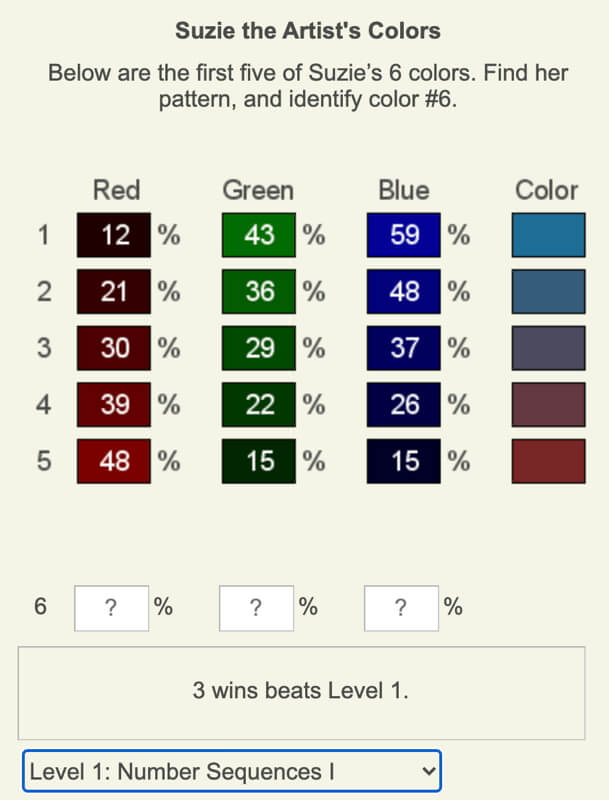
Screenshot of Suzie The Artist game. In this sequence of colors, notice how the red, green, and blue intensities consistently change with each pick.
How To Play
After typing the red, green, and blue color intensities (RGB) for the next color in the sequence, click on the “Check” button that appears to see how you did. Hints appear when you are wrong. Identify the remaining color to win. Three incorrect guesses, and you lose.
Color intensities range from 0% (no color present) to 100% (maximum possible color present). Since red, green, and blue are unique colors, the three’s total intensity doesn’t need to add to 100%. To visually explore the Red/Green/Blue color space, see Color Vectors.
There are six game levels. Winning three games automatically moves you up a level, but you may also select whatever level you want to play.
Although the game uses RGB color intensities, you don’t need to be an expert in colors to play the game, but visual patterns may be useful in looking for numerical patterns. Every game is randomly generated, so you have a nearly unlimited number of challenges to try!
Ages: Middle school and up.
Examples of Ways to Play
Explore illustrated examples that show how to use data, graphs, and functions to solve a more advanced numerical challenge on Suzie the Artist.
Level 1: Sequences I
Each sequential term changes by adding/subtracting a constant value.
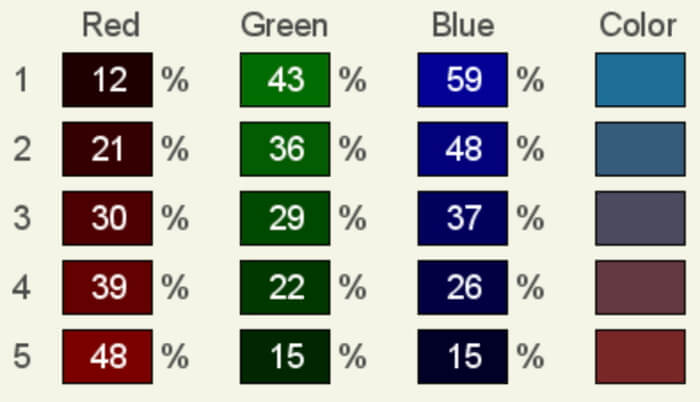
What is Suzie's pattern?
With each pick, Red increases by 9 percentage points, Green decreases by 7, and Blue decreases by 11.
Level 2: Sequences II
Each term increases by adding/subtracting a constant value, a decreasing value, or an increasing value.
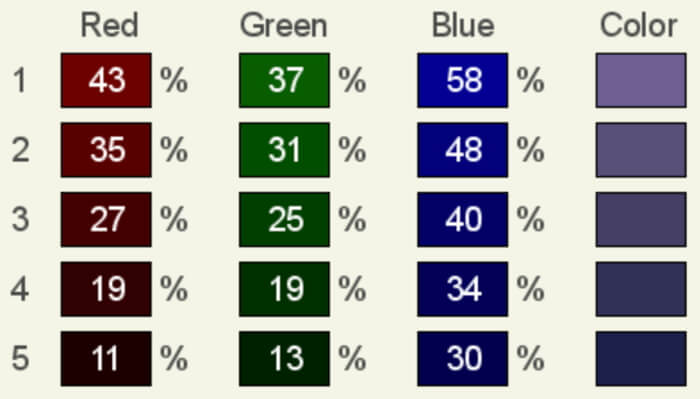
What is Suzie's pattern?
Red decreases by 8 percentage points, Green decreases by 6, and Blue decreases at a decreasing rate of 2 with each pick.
Level 3: Sequences, Pairs, & Sets
Pairs are linear relationships between two colors, and sets are groupings (say, even integers) of numbers presented in any order.
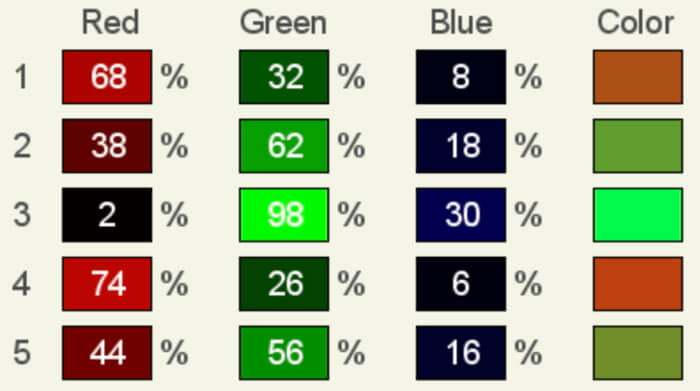
What is Suzie's pattern?
Green = 3 * Blue + 8
Red = 100 – Green
Blue intensities are even.
Level 4: Pairs & Sets
Pairs now include an expanded range of relationships between two colors.
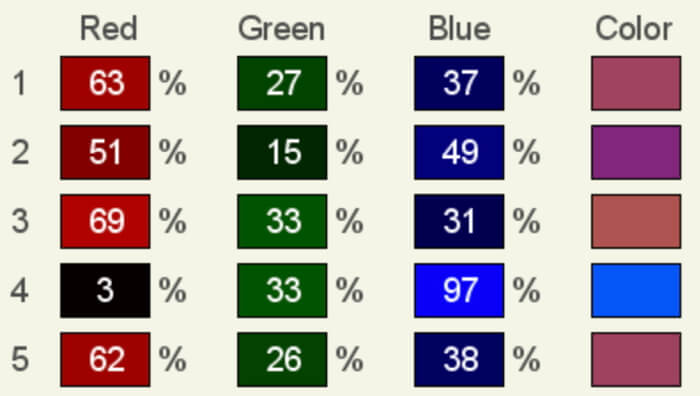
What is Suzie's pattern?
Blue = 100 – Red
Green = |36 – Red|
Red is divisible by 3.
Level 5: Triplets and Pairs
Triplets are multivariable relationships between all three color intensities.
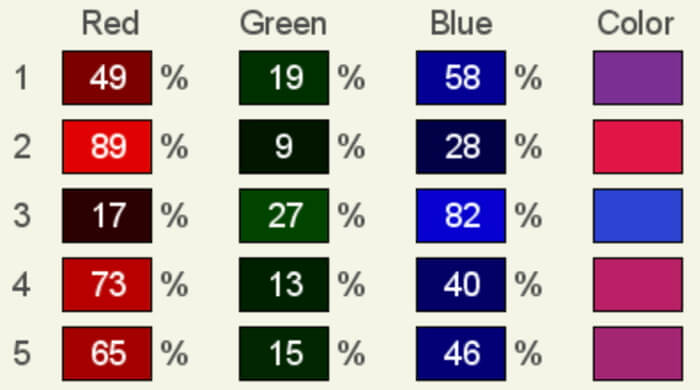
What is Suzie's pattern?
Red + Green + Blue = 126
Blue = 3 * Green + 1
Green are odd numbers.
Level 6: Expert
Challenging versions of each of the categories in the previous levels.
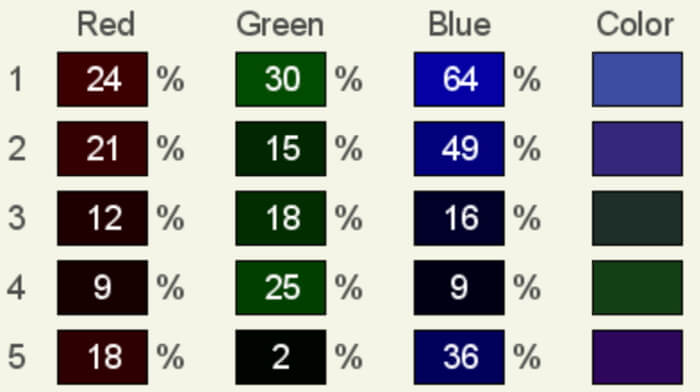
What is Suzie's pattern?
Blue = (Red / 3)²
Green = | Blue – 34 |
Red intensities are divisible by 3.
Types of Questioning Being Tested
Questioning how you observe something helps you focus your attention on looking for patterns and their absence. Asking what something represents, what something means, and what something isn’t are useful starting questions.
The game is challenging – most likely, you will not be able to solve each pattern quickly. When struggling, ask questions that “unconfuse,” which means you first need to identify what is confusing you. Sometimes this means identifying your biases. For example, working with numbers brings out preferences based on how you most frequently use numbers in your math courses. Questions help determine the causes of confusion and then identify the steps to unconfuse yourself.
Questions to Consider as You Play
How do you merge clues from different types of data?
Can randomness be part of a pattern?
Do numbers provide only quantitative data?
Can numbers provide qualitative information, such as the relative value of one number to another?
How do you handle initial confusion to begin creating a plan of attack to solve the challenge?
Does guessing provide new clues?
How do you process feedback differently when correct and when incorrect?
Where Do We Use These Skills?
The motivation for creating this game was to provide experiences I had as a scientist – looking for patterns in numbers. In the field sciences (geology, meteorology, astronomy, field biology, environmental science, oceanography, etc.), there is often a sense of randomness in the data we use. Nature doesn’t usually provide clues in an orderly sequence of numbers. Thinking about it, almost all of the data used in business are like this. In any scenario that uses data, one of the critical skills is finding patterns in the data you are using.

0 Comments